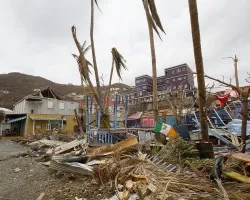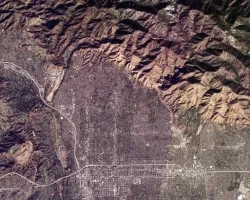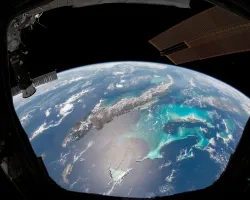Frank Monaldo is developing innovative techniques for measuring the thickness of oil spills from space using satellite remote sensing, research that is supported by NASA’s Earth Science Applied Sciences Disasters program.
Monaldo was first introduced to science as a child through the attention paid to astronauts and outer space in the 1960s. “When I was growing up, astronauts were the cool thing to be.” Although he didn’t pursue a career as an astronaut, Monaldo’s interest in space led him to study physics. After graduating high school, he received his Bachelor of Arts (summa cum laude) and Master of Science in physics from the Catholic University of America in Washington, D.C. After college, he accepted a position at Johns Hopkins University’s Applied Physics Lab (APL) rather than pursuing a Ph.D. He says, “When I first came to APL, they had an interesting philosophy. They decided to hire in some of the master’s degree folks; they have almost the same course work (as the Ph.D.’s) but without the biases on kind of work they want to do.” He explains how he earned his earliest scientific credentials through publishing in scientific literature. “All things being equal, I don’t think I could have followed the same path starting out today.”
The timing was fortuitous for Monaldo in other ways. In 1978, NASA had just launched its first spaceborne Synthetic Aperture Radar (SAR) on the Seasat satellite–the first Earth-orbiting satellite designed for remote sensing of the Earth's oceans. A colleague in the Ocean Remote Sensing Group at APL introduced him to the emerging world of SAR. SAR offers unique advantages compared to optical imagers, such as the ability to peer through storm clouds and monitor areas day or night. Monaldo understood the potential of SAR to detect and map an array of phenomena such as marine wind speed, ocean surface waves, ice motion, ship locations and marine debris. Throughout his career, he has published extensively on using SAR imagery to make geophysical measurements.
Monaldo also developed code and software protocols to use SAR data to create products for the National Oceanic and Atmospheric Administration (NOAA). NOAA most recently implemented an operational oil spill extent product that the agency’s Satellite Applications Branch uses along with other data to produce Marine Pollution Surveillance Reports. These reports are sent, if necessary, to first responders such as the United States Coast Guard.
NOAA’s Office of Response and Restoration is responsible for assessing the status of and potential damage to offshore platforms and pipelines as well as ecological impacts after disasters. As the lead science agency for coastal oil spills, the NOAA uses satellites, aircraft, ships, buoys, and gliders to collect and provide mission-critical information for the emergency response to disasters such as the Deepwater Horizon oil spill in 2010. Scientists have been using SAR technology to map oil extent as far back as the Deepwater Horizon event, but Monaldo’s current work extends oil spill detection capability to estimates of oil thickness.
NASA Applied Sciences Research: How Thick is the Slick?
Monaldo’s current research project within the NASA ROSES A.37 Disasters Response and Risk Reduction Projects portfolio is called “Development and Implementation of Remote Sensing Techniques for Oil Spill Monitoring and Storm Damage Assessment in an Operational Context.” The project uses SAR along with traditional Earth observation platforms to automatically detect and characterize oil thickness through the clever use of a “contrast ratio” algorithm. As crude oil spreads and becomes thinner, it changes from black or brown to an iridescent or silver sheen. The “Marine Oil Spill Thickness” or MOST product compares the extent of a SAR image brightness reduction in oil-covered areas with open water to assess thickness. According to Monaldo, the thickness classification will be a general one, “it’ll be more like Starbucks; tall, grande, or venti, so for oil, it’ll be a sheen, moderate thickness, or thick oil.”
He explains why knowing where oil is thickest is crucial, “You want to gather up the thick oil and prevent it from coming ashore; it’s called ‘actionable oil.’” “If you can have an algorithm that mostly automates the process to give NOAA analysts not only extent, but thickness, they can act quickly to get an assessment to response agencies so that they can deploy resources faster.” That, in turn, helps protect ecosystems and economies.
Making the MOST of Partnerships in Challenging Times
Currently, NOAA/NESDIS Satellite Analysis Branch uses an operational oil extent product to inform the U.S, Coast Guard and other first responders as well as NOAA’s Office of Response and Restoration. NOAA’s National Environmental Satellite, Data, and Information Service (NESDIS) specified the requirements for the new Marine Oil Spill Thickness application as a candidate for operational implementation in November 2020.
NOAA implements SAR applications within a software infrastructure known as the SAR Ocean Products System (SAROPS). Planned as both a research and operational environment, SAROPS was designed from the ground up to easily incorporate new sources of SAR data as they become available. It is also sufficiently modular to add new products or applications once the appropriate algorithm is defined.
Another crucial step in creating an oil thickness product is the verification of candidate oil thickness algorithms with validation in the field. Key partners on the project scheduled an important field test in March 2020, but the COVID-19 pandemic delayed those plans for more than a year. Finally, in May 2021, Monaldo from the University of Maryland joined experts from NASA’s Jet Propulsion Laboratory (JPL), NOAA, the U.S. Coast Guard, as well as the private companies Marine Spill Response Corporation, and Water Mapping LLC to verify the algorithm with focused field-testing near natural oil seeps off the coast of Santa Barbara, California.
The tests used a NASA aircraft equipped with a SAR (UAVSAR) and another low-flying plane with various optical sensors while researchers onboard a U.S. Coast Guard cutter took direct measurements of oil with a mechanical sampler. The team also deployed drones from the Coast Guard cutter to classify the oil with a multi-spectral imager. Publicly traded Canadian company MacDonald Dettwiler Associates (MDA) and the Canadian government agency responsible for weather and meteorological information, Environment Canada, helped gather and interpret supplemental measurements by optical and radar satellites. The team also used NOAA’s Environmental Response Management Application (ERMA) system to collate and present measurements online during the experiment and used GPS data from the cutter to help understand the context of the shipboard measurements with satellite imagery. The test successfully enabled researchers to compare snapshots by multiple remote sensors, including SAR, to actual conditions. Additional field testing is planned for Santa Barbara in the fall and in Norway next year if conditions allow.
Looking Toward the Future
Over time, researchers can add techniques and instruments to augment the algorithm and continually improve its capability. Meanwhile, more SAR assets are coming online around the world, which opens doors to increased opportunities for Monaldo’s work to make a difference. With the launch and operations of Sentinel-1A/B and Radarsat Constellation Mission, commercially tasked systems, and the upcoming launch of the NASA-ISRO SAR (NISAR), SAR imagery of oil spills will continue to have a significant impact.
By the time this project is finished, Monaldo will be in his late 60s. He retired from Johns Hopkins University in January 2020 but eagerly resumed working part-time as faculty at the University of Maryland when NASA accepted his oil spill research proposal. “Getting a NASA proposal funded is like batting in the major leagues,” he says. “If you get one in three, it’s really good.” It’s evident that the chance to work with his co-investigators on the project at NASA, NOAA and within the commercial sector also inspired Monaldo to put his retirement on hold. Once the pandemic subsides and he has finished his oil spill research project, he plans to spend some time enjoying travel photography. “Someone once told me that as you get older, you should plan to go to the farthest places away first,” he says. “The younger you are, the more capable you are of doing that stuff.” Iceland and the Galapagos Islands are among his top destinations.
Monaldo’s Advice for Students
Monaldo offers a final piece of advice for students pursuing careers in Science Technology Engineering or Math (STEM) today: To pursue your own research, learn to be an entrepreneur. “When you go to a place like NASA for a grant, you have to tell a story about why you think that what you do is important,” he notes. “If you write a proposal and all you do is go into the technical details, the reviewers of the proposal are going to sit there and shrug their shoulders.” He explains, “All researchers know how to solve problems in their field and utilize the necessary tools and instruments to be successful, but one may not have the opportunity to use those skills without the ability to tell a compelling story of the impact of the work on the planet and on humanity.”
(NASA Disasters program’s Timothy "Seph" Allen contributed to this story.)










